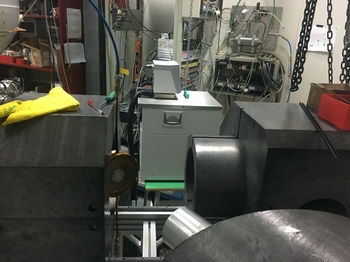23Na(p,γ)24Mg
PI: Gianluca Imbriani
Astrophysical Motivation:
Asymptotic Giant Branch (AGB) stars provide a major contribution to the synthesis of the elements in the cosmos and specifically to the chemical evolution of stellar clusters and galaxies. The more massive AGB stars undergo proton captures at the base of the convective envelope (hot bottom burning, HBB). When the convective envelope extends down to the H-burning shell, the ashes of the CNO, NeNa and MgAl cycles appear at the stellar surface. The coupling between convection and nuclear burning is responsible for the synthesis of various isotopes of Na, Mg and Al.
Combined, the uncertainties of the 23Na(p,γ)24Mg and the 22Ne(p,γ)23Na reaction rates account for the major nuclear contribution to the uncertainty of predicted 23Na and 24Mg yields from these massive AGB stars. The 23Na(p,γ)24Mg reaction, in particular, is the bridge between the NeNa and MgAl cycles.
Experimental Aims
The temperatures at the bottom of the convective envelopes range between 50 < T <110 MK, increasing with the stellar mass and decreasing with the metallicity. The 23Na(p,γ)24Mg reaction rate in this temperature range is dominated by two resonances at Ep = 140 and 251 keV, where Ep is the proton beam energy in the laboratory system. At lower energies, the non-resonant capture contribution dominates the reaction rate, whereas another narrow resonance at Ep = 309 keV is the principal component of the reaction rate at higher temperatures, up to T = 1 GK. The upper limit on the strength of the 140 keV resonance does not exclude this resonance from being the dominant contribution to the reaction rate at T ≈ 80 −90 MK. In fact, the uncertainty of the 23Na(p,γ)24Mg reaction rate in the discussed temperature range, associated with the upper limit of the 140 keV resonance strength and the 33% relative uncertainty of the 251keV resonance strength, provide a strong motivation for an experimental study of these resonances.
Experimental Setup
We have used two complementary detection approaches: high efficiency with a 4πBGO detector for the 140 keV resonance, and high resolution with a HPGe detector for the 251 keV resonance. Thanks to the reduced cosmic ray background of LUNA, we were able to determine the resonance strength of the 251 keV resonance as ωγ251 = (482 ± 82) μeV and observed new γ-ray transitions for the decay of the corresponding state in 24Mg at Ex = 11931 keV. With the highly efficient BGO detector, we observed a signal for the 140 keV resonance for the first time in a direct measurement, resulting in a strength of ωγ140 = 1.46+0.58−0.53 neV (68% CL). Our measurement reduces the uncertainty of the v reaction rate in the temperature range from 0.05 to 0.1 GK to at most +50%−35% at 0.07 GK. Accordingly, our results imply a significant reduction of the uncertainties in the nucleosynthesis calculations.
Publications
Direct measurements of low-energy resonance strengths of the 23Na(p,γ)24Mg reaction for astrophysics
Physics Letters B 795 (2019) 122-128


